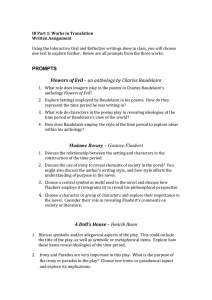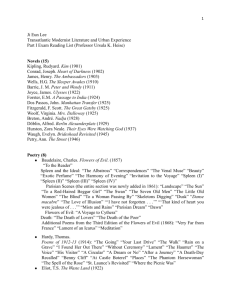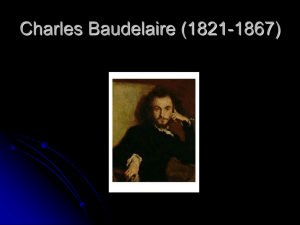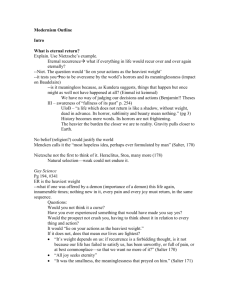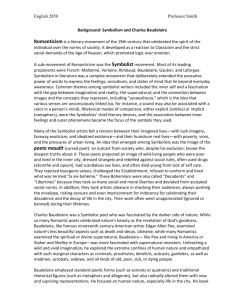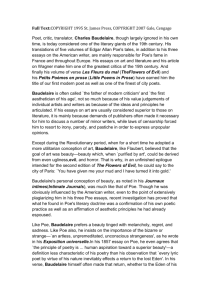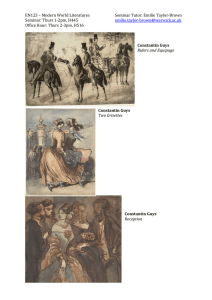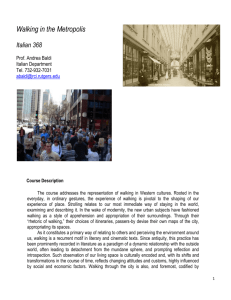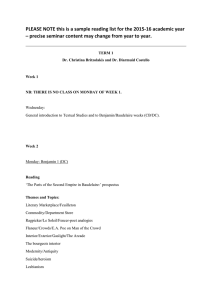chockformige Wahrnehmung
advertisement
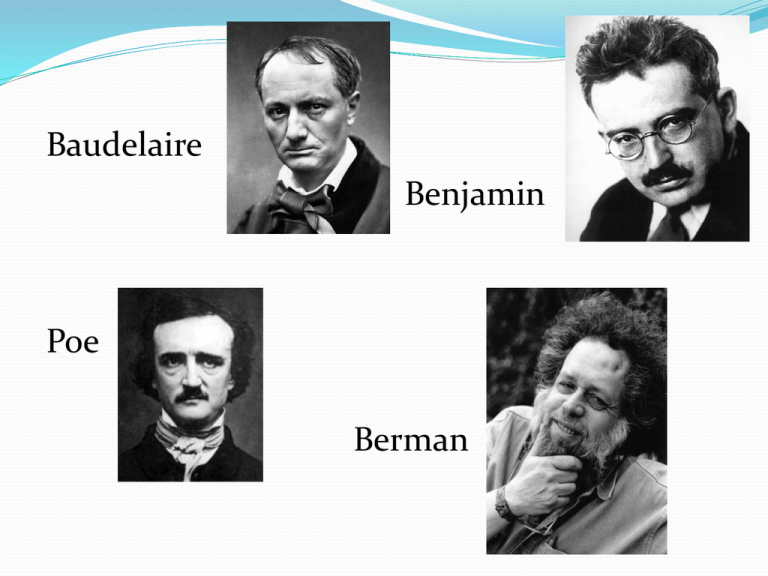
Baudelaire Benjamin Poe Berman Berman: “In the late 1850s and through the 1860s, while Baudelaire was working on Paris Spleen, Georges Eugène Haussmann, the Prefect of Paris and its environs, armed with the imperial mandate of Napoleon III, was blasting a vast network of boulevards through the heart of the old medieval city. Napoleon and Haussmann envisioned the new roads as arteries in an urban circulatory system. These images, commonplace today, were revolutionary in the context of nineteenth-century urban life. The new boulevards would enable traffic to flow through the center of the city, and to move straight ahead from end to end – a quixotic and virtually unimaginable enterprise till then.” www.youtube.com/watch?v=RRv56gsqkzs “Since Baudelaire was himself vulnerable to being frightened, it was not unusual for him to evoke fright. Vallés tells us about his eccentric grimaces; on the basis of a portrait by Nargeot, Pontmartin establishes Baudelaire's alarming appearance; Claudel stresses the cutting quality he could give to his utterances; Gautier speaks of the italicizing Baudelaire indulged in when reciting poetry; Nadar describes his jerky gait.” Benjamin: “Marx says that revolutions are the locomotive of world history. But perhaps it is quite otherwise. Perhaps revolutions are an attempt by the passengers on this train – namely, the human race – to activate the emergency brake” Brecht: “Don’t start from the good old things, but from the bad new ones”. “Moving through this traffic involves the individual in a series of shocks and collisions. At dangerous intersections, nervous impulses flow through him in rapid succession, like the energy from a battery. Baudelaire speaks of a man who plunges into the crowd as into a reservoir of electric energy. Circumscribing the experience of the shock, he calls this man ‘a kaleidoscope endowed with consciousness’. Whereas Poe’s passers-by cast glances in all directions, seemingly without cause, today’s pedestrians are obliged to look about them so that they can be aware of traffic signals. Thus, technology has subjected the human sensorium to a complex kind of training. There came a day when a new and urgent need for stimuli was met by film. In a film, perception conditioned by shock [chockformige Wahrnehmung] was established as a formal principle. What determines the rhythm of production on a conveyor belt is the same thing that underlies the rhythm of reception in the film.” (328) “Marx had good reason to stress the great fluidity of the connection between segments in manual labor. This connection appears to the factory worker on an assembly line in an independent, objectified form. The article being assembled comes within the worker's range of action independently of his volition, and moves away from him just as arbitrarily.” (328) “The jolt in the movement of a machine is like the socalled coup in a game of chance. The hand movement of the worker at the machine has no connection with the preceding gesture for the very reason that it repeats that gesture exactly. Since each operation at the machine is just as screened off from the preceding operation as a coup in a game of chance is from the one that preceded it, the drudgery of the laborer is, in its own way, a counterpart to the drudgery of the gambler. Both types of work are equally devoid of substance.” (330) Erlebnis Erfahrung the isolated experience of the moment long experience mémoire volontaire mémoire involontaire reminiscence memory information event embedded in experience newspapers/photography storytelling decline of aura aura The greater the shock factor in particular impressions, the more vigilant consciousness has to be in screening stimuli; the more efficiently it does so, the less these impressions enter long experience [Erfahrung] and the more they correspond to the concept of isolated experience [Erlebnis]. Perhaps the special achievement of shock defense is the way it assigns an incident a precise point in time in consciousness, at the cost of the integrity of the incident's contents. (319) In turn, there is a contrast between all these forms and the story, which is one of the oldest forms of communication. A story does not aim to convey an event per se, which is the purpose of information; rather, it embeds the event in the life of the storyteller in order to pass it on as experience to those listening. It thus bears the trace of the storyteller, much the same way an earthen vessel bears the trace of the potter’s hand. (316) If we think of the associations which, at home in the mémoire involontaire, seek to cluster around an object of perception, and if we call those associations the aura of that object, then the aura attaching to the object of a perception corresponds precisely to the experience [Erfahrung] which, in the case of an object of use, inscribes itself as long practice. The techniques, inspired by the camera and subsequent analogous types of apparatus extend the range of the mémoire volontaire; these techniques make it possible at any time to retain an event – as image and sound – through the apparatus. (337) To experience the aura of an object we look at means to invest it with the ability to look back at us. This ability corresponds to the data of memoire involontaire. (338) Dandyism appears especially in those periods of transition when democracy has not yet become all-powerful, and when aristocracy is only partially weakened and discredited. (421) There was the pedestrian who would let himself be jostled by the crowd, but there was also the flâneur, who demanded elbow room and was unwilling to forgo the life of a gentleman of leisure. Let the many attend to their daily affairs; the man of leisure can indulge in the perambulations of the flâneur only if as such he is already out of place. He is as much out of place in an atmosphere of complete leisure as in the feverish turmoil of the city. London has its man of the crowd. His counterpart, as it were, is Nante, the boy who loiters on the street corner, a popular figure in Berlin before the March Revolution of 1848. The Parisian flâneur might be said to stand midway between them. (326)
